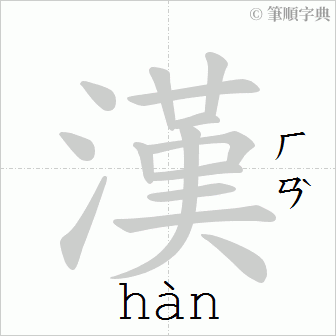漢
- Sino-, China;
It is a culturally and historically rich character that evolved from a river name into a symbol of an entire civilization, ethnicity, language, and at times, manhood or grandeur.
Etymology
漢 originally referred to the Han River (漢水) in ancient China.
Liu Bang, founder of the Han Dynasty (206 BCE – 220 CE), rose to power in the Han River basin (漢中) — and this geographical association became symbolic.
With the Han Dynasty becoming a foundational empire in Chinese history, 漢 came to symbolize:
- The Han people (漢族);
- The Chinese language/writing (漢語 / 漢字);
- The identity of China as a civilization.
Usage in Korean
Language and Ethnicity:
漢字 – Chinese characters;
漢族 – Han ethnicity;
漢語 – Chinese language;
한의학(漢醫學) - Korean traditional medicine (now spelled with 韓)
Surnames and Titles:
- Used in names and titles during imperial or colonial periods.
- In Japan, bestowed to Chinese-origin migrants (e.g. the Aya clan, read as あや in Japanese).
Metaphorical meanings:
"Manly man", "tough guy."
In Japanese, 漢 (おとこ / otoko or あや / aya) is used to describe a rugged or macho man.
Used in expressions like:
괴한 (怪漢) – strange man;
치한 (癡漢) – pervert/molester;
(Here, 漢 = “guy,” “dude,” “fellow” – neutral to pejorative).
Celestial & poetic usage:
銀漢 (은한) – Milky Way (literally “silver Han”).
漢拏山 (한라산) – Halla Mountain, using 漢 to mean “great/high.”
Sometimes used to phonetically transcribe native Korean word “한” (great/big), such as in:
한강 (漢江) – Han River;
한성 (漢城) – former name of Seoul;
한양 (漢陽) – another historic name for Seoul.
Words that derived from 漢
Additional notes
Simplification, Mistakes, and Modern Issues 漢 vs 韓:
漢 = Han Dynasty / Chinese;
韓 = Korea, Korean (as in 韓國).
Mistaking these characters can cause serious meaning shifts:
For example, writing 漢醫學 instead of 韓醫學 may unintentionally imply Chinese traditional medicine rather than Korean.
This confusion occasionally happens in Korean journalism or documents due to:
- Typing errors (漢 is 2nd after 韓 in IMEs);
- Lack of proofreading or misunderstanding.
Alternative forms
In Traditional Chinese, Japanese kyūjitai, Korean hanja, the component 𦰩 for this character is written with 廿 on top. Note that the bottom portion is written 口 overlapped by 夫 and not 中 on top of 天.
In Vietnamese Hán Nôm, 𦰩 can be written with 廿, 龷, or 艹 on top. But the most common variant of 𦰩 is with 龷 written on top.
In Japanese shinjitai, the component 𦰩 is written with 艹 on top and has one stroke less. Due to Han unification, both traditional Chinese and Japanese shinjitai forms are encoded under the same code point. The appearance of this character will differ depending on the font used.
In Simplified Chinese, the component 𦰩 is simplified to 又 instead, giving the character 汉 (U +6C49).
Two compatibility ideographs exist for this character. U+FA47 corresponds to the kyūjitai form of this character while U+FA9A corresponds to the alternative form used in North Korea which is similar to Japanese shinjitai.
- 水廿中人 (ETLO)
- ⿰ 氵 ⿱ 廿 ⿻ 口 夫 (G H T K V)
- ⿰ 氵 𦰩 (J)
